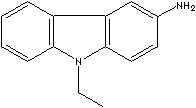PRODUCT IDENTIFICATION

2933.90
CLASSIFICATION
PHYSICAL AND CHEMICAL PROPERTIES
REFRACTIVE INDEX
Stable under ordinary conditions
APPLICATIONS
APPEARANCE
|
|
|
| 9-ETHYL-3-AMINOCARBAZOLE | ||
|
PRODUCT IDENTIFICATION |
||
| CAS NO. | 132-32-1 |
|
| EINECS NO. | 205-057-7 | |
| FORMULA | C14H14N2 | |
| MOL WT. | 210.28 | |
| H.S. CODE |
2933.90 | |
| TOXICITY | ||
| SYNONYMS | 9-Ethyl-9H-Carbazol-3-amine; 9-éthylcarbazole-3-ylamine; | |
| 3-Amino-n-ethylcarbazole; 3-Amino-9-ethylcarbazole; 9-Etilcarbazol-3-ilamina; | ||
| SMILES |
|
|
|
CLASSIFICATION |
|
|
|
PHYSICAL AND CHEMICAL PROPERTIES |
||
| PHYSICAL STATE | yellow to brown crystalline powder | |
| MELTING POINT | 98 - 100 C | |
| BOILING POINT | ||
| SPECIFIC GRAVITY |
| |
| SOLUBILITY IN WATER | Insoluble | |
| pH | ||
| VAPOR DENSITY | ||
| AUTOIGNITION |
| |
| NFPA RATINGS | Health: 2; Flammability: 0; Reactivity: 0 | |
| REFRACTIVE INDEX |
| |
| FLASH POINT |
| |
| STABILITY | Stable under ordinary conditions | |
|
APPLICATIONS |
||
| Carbazole, azafluorene, is a group of organic heterocyclic compounds containing nitrogen atom in dibenzopyrrole system; white crystalline solid, insoluble in water, melts at 244 C. Carbazole and its derivatives are widely used as an intermediate in synthesis of pharmaceuticals, agrochemicals, dyes, pigments and other organic compounds. Carbazole is the basic substance of fluorescent properties. Due to extended pi-electron bond, carbazole is used in luminescence chemistry as a photosensitizing and additional charge transport material. 4,4'-Bis(carbazol-9-yl)biphenyl is used as an OLED hole transport material. Poly(9-vinylcarbazole) is an organic semiconductot. Organic electroluminescence materials have lead to the rapid development of photovoltaic and display devices. Carbazole structure is a motif in pharmaceuticals such as carvedilol used to treat high blood pressure and to prevent cardiac arrhythmias and angina. 4-Hydroxycarbazole is used as an intermediate for the synthesis of pharmaceutical especially for carvedilol. | ||
| SALES SPECIFICATION | ||
|
APPEARANCE |
yellow to brown crystalline powder | |
| CONTENT | 99.0% | |
| MELTING POINT | 98 - 100 C | |
| TRANSPORTATION | ||
| PACKING | 25kgs in fiber drum | |
| HAZARD CLASS | 6. (Packing Group: III) | |
| UN NO. | 2811 | |
| OTHER INFORMATION | ||
| Hazard Symbols: T, Risk Phrases: 23/24/25 , Safety Phrases: 40 | ||
|
|
|